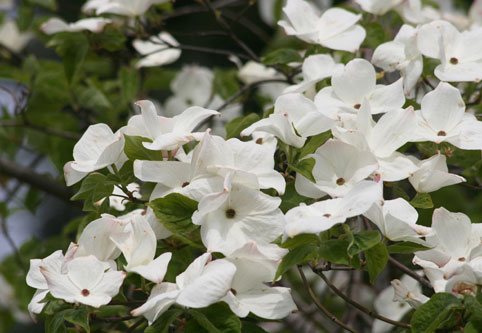
Quick Facts
- Plant Type: Small spreading tree
- Foliage type: Deciduous
- Tree height: 20 to 35 feet high
- Tree width/spread: 15 to 20 feet wide
- Hardiness: USDA Zones 7 to 9
- Flower Color: Large white and abundant
- Sun/light exposure: Full sun or light to open shade
- Water requirements: Occasional watering
- Seasonal Interest: Spring flowers and autumn foliage color
"Eddie's White Wonder" Dogwood (Cornus x)
This unusual hybrid is a cross between the North American native Western dogwood, Cornus nuttallii, and a pink form of the Eastern North American species, Cornus florida. The large flowers open in early spring and have broad overlapping bracts , or false petals, that are brilliant white and abundant. The tree has a narrow shape and distinctive drooping branching habit that works well in the garden and shows the blooms to their best advantage.
This hybrid was developed in British Columbia, Canada, by nurseryman Henry Matheson Eddie (1881-1953), in 1945. It has been reported that the original crosses were done during the late 1930's and 1940's The tree was issued United States Plant Patent #2413 in 1964. It was awarded an Award of Merit in 1972, a First-Class Certificate in 1977, and an Award of Garden Merit by the Royal Horticultural Society.
‘Eddie's White Wonder’ prefers a rich well-drained or sandy soil, but will tolerate clay if the drainage is adequate. Provide a location with full sun to light or open shade. In too much shade or areas without good air circulation foliage disease can be a problem. Once established it only needs occasional watering during dry weather. Little pruning is needed and can ruin the lovely layered branching pattern. It has shown resistance to dogwood anthracnose, a common foliage disease of Eastern Dogwoods.
Like all Dogwoods, this tree is slow to establish and often take two to three years to fully recover from planting.
The tree on the grounds of the Frederick Law Olmsted Arboretum was provided by the Newport Tree Society in 2016 on the formal dedication of the arboretum. In was planted in honor of the late Gary Meyers, a friend of the Museum.

